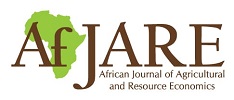Determinants of soybean adoption and performance in Northern Ghana
Courtney A. Tamimie & Peter D. Goldsmith
Abstract
Soybean has been the world’s fastest growing crop over the last 15 years. Yet, as an untraditional and unfamiliar crop, soybean requires small farmers to move beyond their traditional production practices and marketing arrangements in order to produce a successful crop. We employ complexity theory to frame soybean’s production and market differences as significant and non-incremental for smallholder farmers, thus making soybean a ‘long-jump’ agricultural technology problem. We consider three estimation strategies using a primary dataset of smallholder women soybean producers in the Upper West region of Ghana. We first employ probit and ordinary least squares (OLS) regression models to understand adoption and performance. We then employ a combined spatial-autoregressive with spatial-autoregressive disturbances (SARAR) model using generalised spatial two-stage least squares to understand cross-unit interactions in a spatial dimension. We find positive, large and significant spatial autoregressive dependence and knowledge spillover to affect the soybean yields of smallholder female farmers within spatial networks. This finding provides guidance for agricultural development practitioners regarding the importance of social interaction and information provision when promoting long-jump technologies like soybean.
